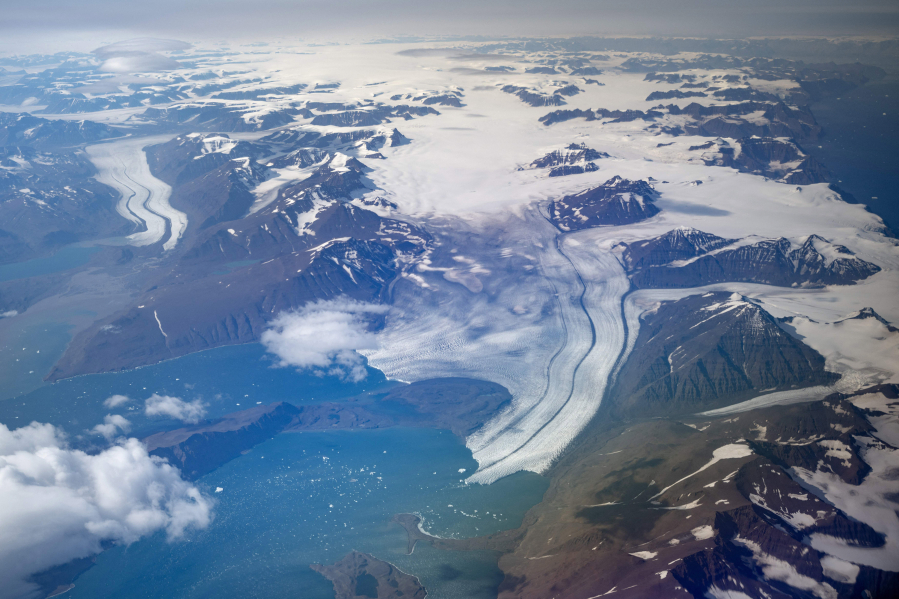The Greenland ice sheet, an expanse of frozen water about three times the size of Texas, is disappearing much faster than previously thought, according to new research, and the difference may already be affecting the distribution of heat around the world.
The mass of ice lost between 1985 and 2022 has been underestimated by as much as 20 percent, or more than 1,000 gigatons. That’s due to the overlooked impact of calving around Greenland’s perimeter, where the sheet’s glaciers meet the sea, scientists wrote in an article published Wednesday in Nature.
Using several public datasets, the research team combined more than 235,000 observations of glacial end points to create an “ice mask” showing the extent of the ice sheet every month from 1985 to 2022.
“The surprise was just the ubiquity of the signal,” said Chad Greene, a glaciologist with NASA’s Jet Propulsion Laboratory in Pasadena, Calif., and lead author of the study. With the exception of “one minuscule little glacier” that grew modestly, Greene said, “there’s just been retreat everywhere we’ve looked. It’s on every corner of the island.”
The shrinking of Greenland’s ice sheet is already contributing to higher seas, but the melting studied by Greene and his team likely had minimal impact because it occurred in deep fjords leading into the ocean, where the ice was already mostly underwater. However, as that part of the glaciers disappears, inland melting is likely to accelerate and will raise sea levels as that water flows into the ocean.
“What we’re seeing is that the clog in this bottleneck has been removed, and as a result, the glaciers all around Greenland have been able to speed up” the melting process, he said. “You take the ice out of the fjord, and glaciers speed up and start contributing to sea level rise.”
Figuring out how much more ice is going to be lost, and how quickly, also depends on the sensitivity of various glaciers to climate change. The extent of the glaciers fluctuates seasonally, growing in winter and retreating in summer. Those that consistently changed the most are likely the most sensitive to environmental change and global warming, the scientists surmised.
“This finding is sort of laying a roadmap of where to look for which glaciers that are going to be potentially the biggest players over the next few decades in sea level rise,” Greene said.
Greenland’s ice sheet is retreating because of warmer global temperatures caused by the human combustion of fossil fuels. Prior to this study, the total mass loss from the sheet so far was estimated at about 5,000 gigatons, according to IMBIE, a collaboration of polar scientists. Were it all to melt, sea levels could rise more than 23 feet.
Meanwhile, the loss through calving — when icebergs break off the glacier and float out to sea — is already significant enough that it may be affecting ocean circulation and the distribution of heat energy around the globe, the study suggests. This could have particular importance for Atlantic Meridian Overturning Circulation.
Atlantic Meridian Overturning Circulation can be described as a planetary conveyer belt of energy that circulates warm water from lower latitudes up to the North Atlantic and back again. In addition to warming much of Europe and the U.K., that circulation carries nutrients with it that are key to sustaining ocean life.
The annual freeze of the surface of the Arctic Ocean is a driver of the conveyer belt. Ice cannot contain salt, and so as Arctic sea ice freezes, the salt is pushed out and sinks to the bottom of the sea. That denser salt water then flows south, which in turn pulls warm water north.
Scientists are divided as to whether Atlantic Meridian Overturning Circulation is approaching a tipping point when even a relatively small amount of melting fresh water could disrupt the cycle. But it seems likely that a larger inflow could have an impact.
“We found an extra thousand gigatons (of lost ice), and now we’re saying to ocean modelers, ‘Put this in your models and see if it affects things,’” Greene said.
That 1,000 gigatons figure is significant — “much larger than I would have hypothesized,” said Julienne Stroeve, chief science officer at Arctic Basecamp, a nonprofit group of Arctic experts, and a professor of polar observation and modeling at University College London. The impact it may be having on ocean circulation warrants investigation, Stroeve said.
“The only region of the planet that’s kind of cooling is actually off the southeastern coast of Greenland, in the ocean, and that could be due to freshening of the ocean from more melt water from Greenland,” Stroeve said.



